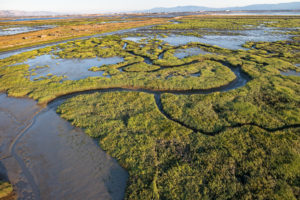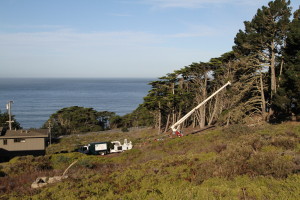Barbara Salzman was “hooked on nature” after taking her young son on field trips with Elizabeth Terwilliger, Marin’s legendary environmental educator. Salzman is now president of the Marin Audubon Society (MAS), which celebrates its 50th anniversary this year. The organization is best known for birding trips, but under Salzman’s dedicated direction, MAS has become a significant force in purchasing and restoring over a thousand acres of wetland habitat.
BN: About ten years ago, MAS began buying land. Is that typical for an Audubon chapter?
BS: Not really, but a small group of us got together after losing what became StoneTree Golf Club along Highway 37 near Novato. We didn’t want to lose more bayshore wetlands in Marin County, so we made a list of properties at risk, collected funds, and did public outreach. Lo and behold, one of our members connected with a real estate agent for a developer who owned Triangle Marsh in Corte Madera and that became our first acquisition. Since then, we’ve made about a dozen purchases. We restore wetland habitat on our properties and then donate some to the Marin County Open Space District or the Department of Fish and Game. About 20 years ago, we began doing small wetland restorations on land owned by others. Those small projects gave us the experience necessary to do larger projects on our own properties.
BN: What led you to focus on wetlands?
BS: In the 1950s, everyone was interested in ridgetops and uplands, so in the 1960s, MAS decided to focus more on wetlands. Nowadays that sounds so normal, but back then it sounded crazy. Here we have the San Francisco Estuary, the most important estuary on the West Coast, and hardly anyone was paying attention to it. Look at San Rafael. It had all the backsides of its buildings toward the Bay. People put landfills on the Bay. No one was talking about it. We’re trying to make up for that.
One of our biggest acquisitions was Bahia, the 623-acre site in Novato, along the Petaluma Marsh. The local government had approved a housing development there but the people of Novato voted it down in 2002. After months of negotiation, the owner called and said he wanted to sell it to us quickly. We worked on that one for 25 years.
BN: Are there still areas in Marin to be preserved?
BS: We developed a list of 39 properties, both wetlands and adjacent uplands, and we’re working our way through them. The developers need to know that it’s going to be a long hard struggle with us opposing them. Sometimes that’s effective, but we have lost a couple. One is a little school district site in Mill Valley that they want to put a playing field on. The other one is near the county airport, Gnoss Field in Novato. We’re hoping to protect two others. St. Vincent’s and Silveira are owned by two different owners right next to each other, and Miller Creek goes through both properties, north of San Rafael.
BN: You were present last December when a dike was removed to flood part of Petaluma Marsh that had been a landfill. Have you been back since?
BS: I’ve been back three or four times and it looks great. A lot of birds are using it already—egrets, herons, lots of ducks, diving birds. I saw hundreds of white pelicans there one day. You see birds using wetlands that some people say are not important. Two winters ago there was a big storm at Christmastime around the Audubon Christmas bird count. This area that the school district in Mill Valley wants to turn into a playing field had 40 red phalaropes. All these birds—blown in from the ocean—needed a place that was relatively calm and they found this tiny wetland. There’s no other seasonal wetland in that area.

.jpg)



